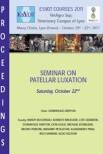Summary
Reasons for performing study
While surgical arthrodesis is the treatment of choice for osteoarthritis of the proximal interphalangeal joint, some clients are unable to pursue surgery due to costs. A more economical technique was sought using intra-articular ethyl alcohol injections to facilitate ankylosis.
Objectives
To describe the technique and outcome of intra-articular ethyl alcohol injections for facilitated ankylosis of proximal interphalangeal joints with osteoarthritis.
Methods
As a retrospective case series, the medical records (2006–2012) of clinical cases diagnosed with proximal interphalangeal joint osteoarthritis treated with intra-articular ethyl alcohol injections were reviewed. Cases with follow-up of at least 6 months were included. Technique and outcome were determined. Evaluation of outcome was assessed using return to previous performance or intended use and owner satisfaction as the indicators of success. Soundness and level of work are also reported.
Results
Thirty-four horses were included in the study. At the time of follow-up, 17 horses (50%) were sound, while 13 horses (38%) were improved but not sound. One horse's lameness was unchanged, and 3 horses were lost to follow-up. The median time until horses became sound or returned to work was 8 months. Six horses had complications, 4 of which were mild and transient.
Conclusions and potential relevance
The use of intra-articular ethyl alcohol in the proximal interphalangeal joint in horses affected by osteoarthritis appears to be a viable method for facilitated ankylosis if surgical management is not an option.









